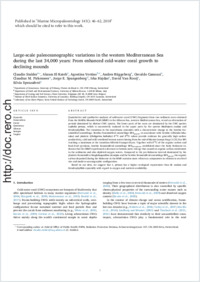Large-scale paleoceanographic variations in the western Mediterranean Sea during the last 34,000 years: From enhanced cold-water coral growth to declining mounds
- Stalder, Claudio Department of Geosciences, University of Fribourg, Switzerland
- El Kateb, Akram Department of Geosciences, University of Fribourg, Switzerland
- Vertino, Agostina Department of Earth and Environmental Sciences, University of Milano-Bicocca, Italy - Department of Geology and Soil Science, Ghent University, Belgium
- Rüggeberg, Andres Department of Geosciences, University of Fribourg, Switzerland
- Camozzi, Osvaldo Department of Geosciences, University of Fribourg, Switzerland
- Pirkenseer, Claudius Department of Geosciences, University of Fribourg, Switzerland
- Spangenberg, Jorge E. Institute of Earth Surface Dynamics, University of Lausanne, Switzerland
- Hajdas, Irka Laboratory of Ion Beam Physics, Swiss Federal Institute of Technology Zurich, Switzerland
- Rooij, David Van Department of Geology and Soil Science, Ghent University, Belgium
- Spezzaferri, Silvia Department of Geosciences, University of Fribourg, Switzerland
-
01.09.2018
Published in:
- Marine Micropaleontology. - 2018, vol. 143, p. 46–62
English
Quantitative and qualitative analyses of cold-water coral (CWC) fragments from two sediment cores obtained from the Melilla Mounds Field (MMF) in the Alboran Sea, western Mediterranean Sea, reveal an alternation of periods dominated by distinct CWC species. The lower parts of the cores are dominated by the CWC species Lophelia pertusa, which is successively replaced in the upper parts by the species Madrepora oculata and Dendrophyllids. The transition in the macrofauna coincides with a characteristic change in the benthic foraminiferal assemblage. Benthic foraminiferal assemblage BFAglacial, in accordance with benthic (Cibicides lobatulus) and planktic (Globigerina bulloides) δ13C and δ18O values provide evidence for generally high surface productivity, cold and well-ventilated bottom waters lasting from the end of Marine Isotope Stage 3 (33.3 ka BP) reaching a maximum at the transition Alleröd–Younger-Dryas. Together with δ13C of the organic carbon and Rock-Eval pyrolysis, benthic foraminiferal assemblage BFAinterglacial established since the Early Holocene indicates that the MMF experienced a decrease in bottom-water energy that caused an organic carbon-enrichment in the sediments and also depleted oxygen waters. Compared to the pre-Holocene interval dominated by the planktic foraminifera Neogloboquadrina incompta and the benthic foraminiferal assemblage BFAglacial, the organic carbon deposited during the Holocene in the MMF contains more refractory components in relation to sea-level rise and modern oceanographic configuration. Based on our data, we suggest that L. pertusa has a higher ecological requirement than M. oculata and Dendrophyllids especially with regard to oxygen and nutrient availability.
- Faculty
- Faculté des sciences et de médecine
- Department
- Département de Géosciences
- Language
-
- English
- Classification
- Biological sciences
- License
-
License undefined
- Identifiers
-
- RERO DOC 323382
- DOI 10.1016/j.marmicro.2018.07.007
- Persistent URL
- https://folia.unifr.ch/unifr/documents/307184
Other files
Statistics
Document views: 123
File downloads:
- pdf: 244
- Supplementary material: 77

